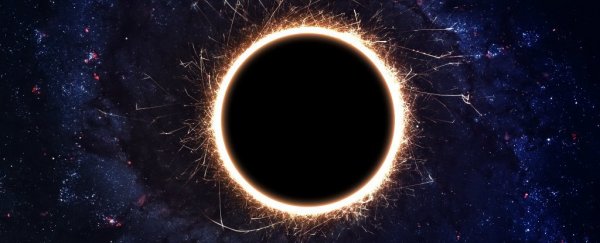Scientists around the world have spent five sleepless nights staring into the abyss, and are hoping they've been rewarded with something that could change physics forever - the first photo of the event horizon at the edge of a black hole.
If their efforts were successful, we might be on the verge of actually seeing the edge of an elusive black hole, allowing us to see if the fundamentals of general relativity hold fast under some pretty extreme conditions. If Einstein was alive, we're sure he'd be excitedly freaking out right now.
The bad news is, we still have a long wait in store before we know whether a worldwide telescope network was able to capture the image or not.
Astronomers around the world have now concluded five nights of black hole observations on two black holes, and need to get 1,024 hard drives worth of data from the Event Horizon Telescope's processing centres at MIT Haystack and the Max Planck Institute for Radio Astronomy in Bonn, Germany so they can begin to study them.
Adding to the challenge is the fact that hard drives located at the South Pole Telescope can't be flown out until the end of October at the close of winter, so it won't be until later this year, or even early 2018, until we get some answers.
But one of the astronomers involved, Heino Falcke from Radboud University in the Netherlands, told National Geographic that even without seeing the data, any tangible observations of black holes will finally take them from "mythical object to something concrete that we can study."
"Even if the first images are still crappy and washed out, we can already test for the first time some basic predictions of Einstein's theory of gravity in the extreme environment of a black hole," Falcke told Ron Cowen.
Black holes are among the most fascinating and elusive objects in the known Universe. But despite the fact that they're suspected to lurk at the centre of most galaxies, no one's ever been able to actually photograph one.
That's because black holes, as the name suggests, are very, very dark. They're so massive that they irreversibly consume everything that crosses their event horizon, including light, making them impossible to photograph even with the most powerful telescopes.
So instead of just using one telescope, in this latest attempt the international team of astronomers used a network of radio telescopes located across the planet, including at the South Pole, in the US, Chile, and the French Alps - known collectively as the 'Event Horizon Telescope'.
As we explained back in February, the telescope works by using a technique known as very-long-baseline interferometry (VLBI), which means this huge network of receivers will all focus in on radio waves emitted by a particular object in space at one time - in this case, Sagittarius A*, the black hole at the centre of the Milky Way, and a second black hole at the centre of the nearby galaxy M87.
Combined, the telescope should achieve a resolution of 50 microarcseconds - the equivalent of being able to see a grapefruit on the surface of the Moon.
And that will hopefully be enough to image the event horizon of Sagittarius A*, which is estimated to be 20 million km (12.4 million miles) or so across - barely a pinprick in the night sky at a distance of 26,000 light-years away from Earth.
The telescope had approval to be switched on for a 10-day viewing window from April 4, but due to weather conditions, only five nights were available - the researchers are detecting radio waves with a wavelength of 1.3 mm (230 GHz), which are absorbed and emitted by water, so observations don't really work when it rains.
The last observation session ended on April 11, National Geographic reports.
So what can we expect to see if the project is successful? Well, that all depends on if Einstein was right or not.
Based on the theory of general relativity, the researchers predict the black hole will look like a bright ring of light around a dark blob, thanks to light being emitted by gas and dust particles that are accelerated to high speeds just before they're ripped apart and consumed by the black hole.
The dark blob at the centre would be the shadow cast over that chaos.
The ring should also appear more like a crescent of light than a perfect circle, because a dramatic Doppler effect should make the material moving towards Earth appear much brighter.
If the team is able to measure the dark shadow cast by the black hole, that will be even more impressive, because general relativity makes some pretty specific predictions about what size it should be, based on how much the black hole should bend space-time.
"We know exactly what general relativity predicts for that size," team member Feryal Özel said in a press conference last year. "Get to the edge of a black hole, and the general relativity tests you can perform are qualitatively and quantitatively different."
There's also the chance we might see something else entirely - and in that case, Einstein's theory of general relativity would need to be completely overhauled.
"As I've said before, it's never a good idea to bet against Einstein, but if we did see something that was very different from what we expect we would have to reassess the theory of gravity," project leader Sheperd Doeleman from the Harvard-Smithsonian Centre for Astrophysics told Jonathan Amos at the BBC.
"I don't expect that is going to happen, but anything could happen and that's the beauty of it."
